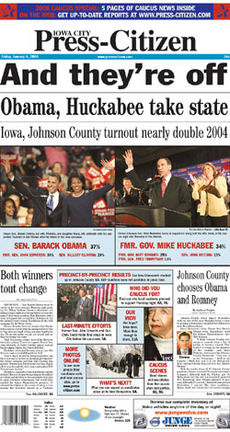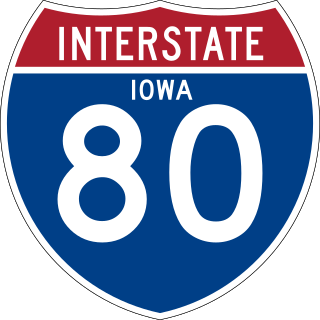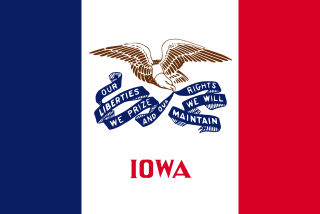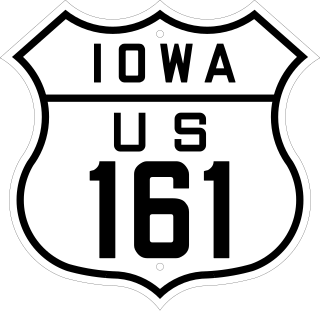
Des Moines is the capital and the most populous city in the U.S. state of Iowa. It is also the county seat of Polk County. A small part of the city extends into Warren County. It was incorporated on September 22, 1851, as Fort Des Moines, which was shortened to "Des Moines" in 1857. It is located on, and named after, the Des Moines River, which likely was adapted from the early French name, Rivière des Moines, meaning "River of the Monks". The city's population was 214,133 as of the 2020 census. The six-county metropolitan area is ranked 83rd in terms of population in the United States with 699,292 residents according to the 2019 estimate by the United States Census Bureau, and is the largest metropolitan area fully located within the state.

Scouting in Iowa has a long history, from the 1910s to the present day, serving thousands of youth in programs that suit the environment in which they live.

Ankeny is a city in Polk County, Iowa, United States and a suburb of the state capital of Des Moines, as part of the Des Moines-West Des Moines, IA metropolitan statistical area. As of the 2020 census, the population of Ankeny was 67,887, making it the seventh largest city in the state. It is one of the fastest-growing cities in Iowa. Currently, the city's incorporated area totals 29.14 square miles.
The Avenue of the Saints is a 563-mile-long (906 km) highway in the Midwestern United States that connects St. Louis, Missouri and St. Paul, Minnesota.

Area code 319 is a telephone area code in the North American Numbering Plan (NANP) for the southeastern and east-central parts of the U.S. state of Iowa.

Area code 641 is a telephone area code in the North American Numbering Plan (NANP) for the central region of the U.S. state of Iowa. The numbering plan aea (NPA) includes Mason City, and Ottumwa. The area code was created in a split of area code 515 on July 9, 2000, which was the first split in Iowa since the establishment of the area code system in 1947.

Area code 515 is a telephone area code in the North American Numbering Plan (NANP) for most of the north-central part of the U.S. state of Iowa. The numbering plan area includes Des Moines, Ames, Ankeny, Humboldt, Boone, Fort Dodge, Jefferson, Johnston, Urbandale, Algona and Indianola.

Iowa Highway 1 (Iowa 1) is a state highway in the U.S. state of Iowa that extends from Keosauqua to Anamosa. It travels nearly 120 miles (190 km), mainly through rich farmland and small communities. Iowa 1 provides an important link to Iowa City and the University of Iowa as it passes through campus. Portions of the route today date back to the late 1830s, when Martin Van Buren was president, making Iowa 1 one of the oldest routes in the state, pre-dating the current primary highway system by nearly eighty years. The highway was seriously damaged by the Cedar River in the Iowa flood of 2008, which closed the highway for seven weeks.

U.S. Highway 6 (US 6) is an east–west United States Numbered Highway which runs 322 miles (518 km) across the U.S. state of Iowa. The route is signed in places as the Grand Army of the Republic Highway. Like all state highways in Iowa, it is maintained by the Iowa Department of Transportation. The route begins at the Missouri River crossing at Council Bluffs. From there, it travels east through Oakland and Atlantic. North of Atlantic, the highway overlaps Interstate 80 (I-80) until De Soto. Between De Soto and Adel, the highway overlaps US 169 before splitting off to the east toward Des Moines. Through the Des Moines area, the highway runs about one mile (1.6 km) north or south of the I-35/I-80 corridor.

The Iowa City Press-Citizen is a daily newspaper published in Iowa City, Iowa, United States that serves most of Johnson County and portions of surrounding counties. Its primary competitors are The Gazette of Cedar Rapids, which has a news bureau in Iowa City, and The Daily Iowan, the University of Iowa's student newspaper.

Interstate 80 (I-80) is a transcontinental Interstate Highway in the United States, stretching from San Francisco, California, to Teaneck, New Jersey. In Iowa, the highway travels west to east through the center of the state. It enters the state at the Missouri River in Council Bluffs and heads east through the southern Iowa drift plain. In the Des Moines metropolitan area, I-80 meets up with I-35 and the two routes bypass Des Moines together. On the northern side of Des Moines, the Interstates split and I-80 continues east. In eastern Iowa, it provides access to the University of Iowa in Iowa City. Northwest of the Quad Cities in Walcott is Iowa 80, the world's largest truck stop. I-80 passes along the northern edge of Davenport and Bettendorf and leaves Iowa via the Fred Schwengel Memorial Bridge over the Mississippi River into Illinois.

The geography of Iowa includes the study of bedrock, landforms, rivers, geology, paleontology and urbanisation of the U.S. state of Iowa. The state covers an area of 56,272.81 sq mi (145,746 km2).

Iowa is a state in the upper Midwestern region of the United States, bordered by the Mississippi River to the east and the Missouri River and Big Sioux River to the west. It is bordered by six states: Wisconsin to the northeast, Illinois to the east and southeast, Missouri to the south, Nebraska to the west, South Dakota to the northwest, and Minnesota to the north.

The environment of Iowa has been heavily affected by agricultural production since it became a U.S. state in 1846. However, there remain natural areas in Iowa that reflect a wide varieties of environmental niches.

U.S. Highway 161 was a U.S. Highway in Iowa that ran from Keokuk to Dubuque by way of Cedar Rapids. It was designated in 1925 and signed in 1926 along two primary highways. The route began at the Mississippi River with US 61 southwest of Keokuk ran north through Mount Pleasant and Iowa City to Cedar Rapids. There, it turned to the northeast through Anamosa and Monticello towards Dubuque. The route ended at US 61 in Key West, a few miles west of Dubuque.

Iowa Highway 60 was a 223-mile-long (360 km) state highway that ran from the Missouri state line near Cincinnati, where it continued as Route 5, to U.S. Highway 18 (US 18) near Wesley. The highway passed through Centerville, Knoxville, Des Moines, and Webster City during its trek. It was an original state highway that was in service for 48 years. The highway originally only extended from Des Moines to Goldfield, but was extended in 1931. At that time, it absorbed Iowa Highway 6. On January 1, 1969, the highway ceased to exist. The Iowa State Highway Commission renumbered several state highways in order to match up route numbers with adjacent state highways. It was replaced by Iowa 5 south of Des Moines and Iowa 17 north of Granger.
The Hedrick Community School District was a school district serving Hedrick, Iowa.

U.S. Highway 63 (US 63) is a United States Highway that runs through the eastern third of Iowa. It begins at the Missouri state line southwest of Bloomfield and travels north through Ottumwa, Oskaloosa, Tama, Waterloo, and New Hampton. It ends at the Minnesota state line at Chester. Between Ottumwa and Oskaloosa, the highway is a four-lane controlled-access highway. Through Waterloo and New Hampton, it is partially controlled; that is, the road as both grade-separated interchanges and at-grade intersections. The rest of the highway is largely a two-lane rural highway.
















